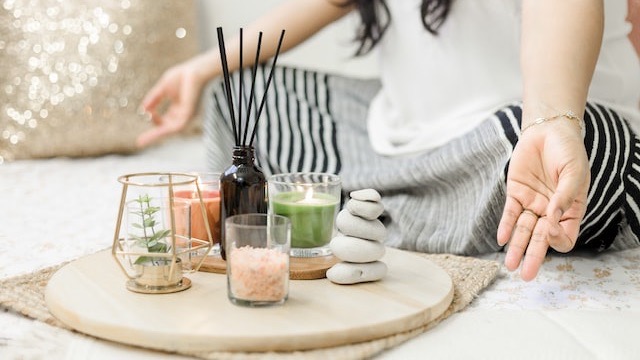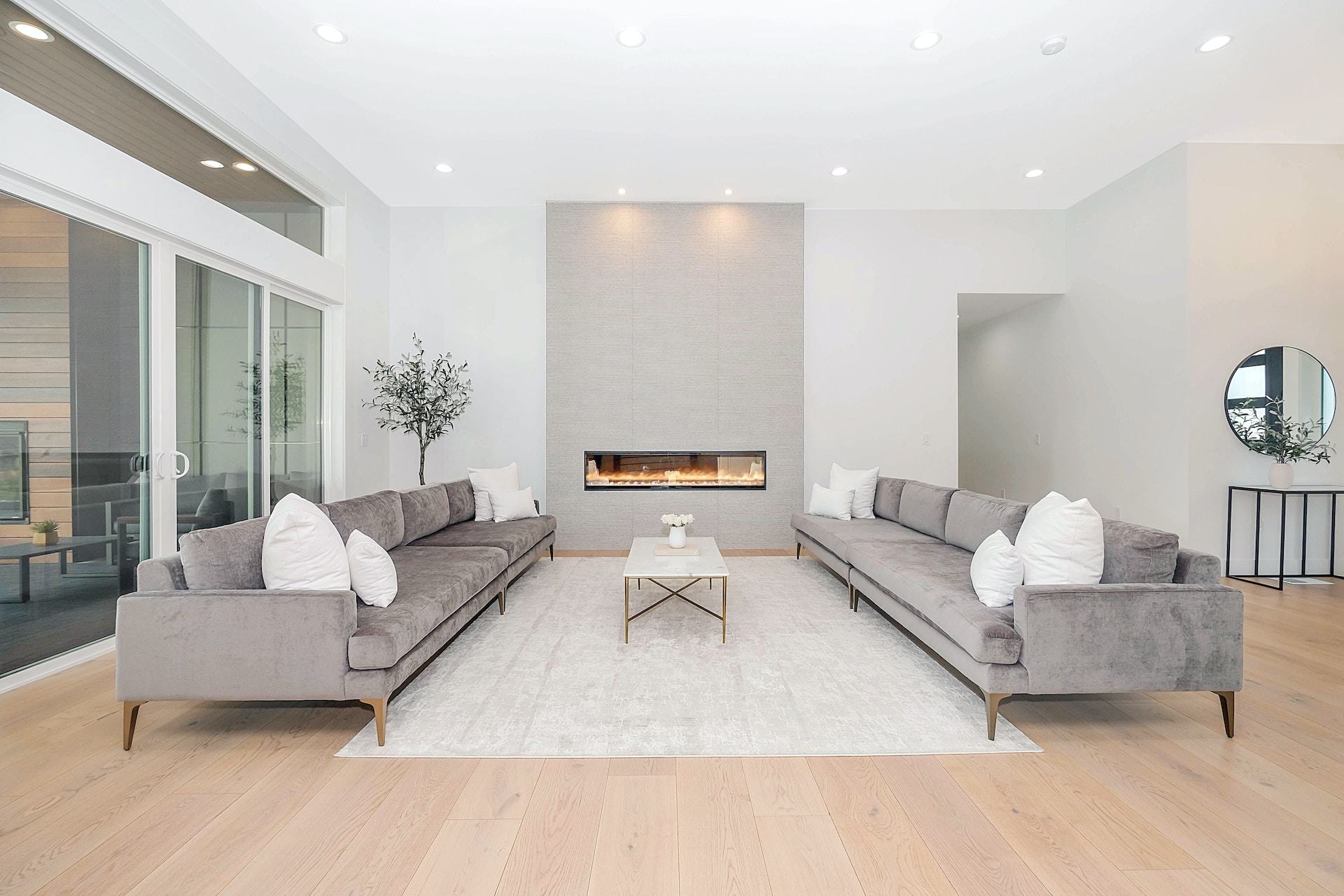Meditation is a vital practice regarding mindfulness, relaxation, and self-care. The act of meditation increases personal awareness while also helping you to stay focused and centered, reducing your stress and anxiety levels. Everyone in the family can take part in meditation, even the kids, regardless of age. Many spiritual people even have their meditation rooms at home to enjoy a refuge of quiet and calm in their own unique space. Your home should always be a place of happiness and tranquility and creating a home meditation room is a key part of that.
It’s important that your entire family practices self-care. Designing a comfortable, quiet meditation space is a great place to start. According to the National Library of Medicine, approximately 76% of people use meditation to improve or maintain general wellness. An analysis of 23 studies in 2021 found that many people dealing with high stress and anxiety found meditation helpful, even more so than some prescription medications.
Even if you don’t suffer from anxiety, doing mindfulness exercises in your meditation room at home can be extremely beneficial. The goal is to find a habit that’ll help you feel centered and calm as you cope with the tasks of everyday life. Incorporating ASMR can also improve your meditation experience. This guide will show you some tips for creating your meditation room at home, practicing awareness and mindfulness, and incorporating ASMR into your plan so that the entire family can participate.
Table of Contents
How to get started with Meditation
Tips to create a meditation room
- Picking a spot
- Clutter-free/stay minimal
- Plan your color palette
- Let sunlight in
- Consider accessories
Other wellness activities/hobbies
How to get started with meditation
You don’t need to be an expert at meditating to get started with this healthy practice. Mindfulness exercise is great for beginners and the more experienced. It helps relieve stress, promotes better mental health, and encourages an overall sense of calm. The key is learning to calm your mind and clear it of anything causing you to feel stress.
Start by choosing a quiet place where you’ll be undisturbed for some time, then begin by sitting in a comfortable position. Take long, deep breaths and listen to your breathing as you let your mind go. Do this for as long as you can or need to, then “come back” by thinking of something positive.
Meditation for kids
The act of meditation is great for everyone, including young children. Kids who practice daily meditation may be able to focus better on schoolwork and deal with the difficulties of childhood, adolescence, and teenhood more effectively. Meditation also teaches children not just to be kind to others but also to themselves.
Making this a part of your child’s daily routine can have a significant impact. Doing even small, short sessions of meditation each day teaches children better coping skills, emotional resilience, focus, and much more. It’s also a great way to get children to go to sleep. Have them meditate before bedtime, and they may begin to notice more profound, more restful sleep and less insomnia.
Meditation techniques
Many different meditation techniques are available, but here are some excellent beginner-friendly options:
- Breathing meditations: In this session, you’ll focus on your breathing and breathing techniques. Proper breathing helps you feel calmer and gets you into the right mindset for a deeper meditation session.
- Mindfulness: This meditation practice involves focusing on something you’re doing or on the meditation itself. Mindfulness teaches you to be intensely aware of the moment and your surroundings.
- Focus: Choose an object or an item in the room and focus on it throughout the entire meditation session. This technique helps you see the details of something so intensely that you don’t notice anything else.
- Mindful walking: Not only is walking great for your health, but mindful walking can be a form of meditation as you focus on nature and get healthy exercise.
- Progressive muscle relaxation: In this technique, you’ll tighten and release several different muscles to help you relieve tension while you meditate.
- Mantra: Choose a song or phrase to repeat over and over again. Doing this aloud every day will help you manifest something you want, like peace or love.
- Crystals: Simply holding crystals in your hand while meditating is a simple way to incorporate them into your practice. This fuss-free connection allows direct bodily contact with your crystals and is a natural choice that invites the sharing of energies and raising vibrations.
Tips to create a meditation room
When you’re ready to create your very own meditation room at home, there are a few key things to keep in mind. Once you’ve designed your new space, you’ll find it to be a happy, tranquil area where you can relax, reset, and work on self-care and your mental well-being. Once the room is complete, don’t forget to use aids like calming meditation music or aromatherapy to help your mind relax.
There are countless ways to make this room your own, but there are some things you should use to improve your family’s meditation experience.
Picking a spot
Before you set up your new home meditation room, you’ll need to designate a spot. If you have a spare bedroom, this is a great place to start creating a personalized space for meditating. Another great option is a corner of your home where you enjoy spending your free time. Here are some ideas to help you choose your favorite new meditation space.
- Choose a corner of your living room beside a window where you can sit down and enjoy the view outside. Add a comfortable floor pillow or chaise lounge so you can sit back and relax while you meditate.
- If you happen to have a space under your staircase, this can transform into a comfy, cozy cubby hole for meditation. Add a thick floor cushion and enclose the area with a curtain to create a nice place for calm and retreat.
- Some people prefer to meditate outside, so consider a spot on your porch or in the garden if you want to connect with nature. Make sure the area is clean and quiet and not too hot or too cold during certain times of the year.
- Select a quiet corner of your library or home office where you can meditate. This is a great way to unwind before or after a stressful workday. Add a hanging chair to the corner to create a completely different seating area.
- Many people enjoy meditating by the fire. Remove furniture in front of your fireplace and replace it with a large floor pillow or mat and a small end table or stool.
Clutter-free/stay minimal
Remember that meditation involves clearing your mind. If your space is cluttered, it’ll be more difficult to relax and feel comfortable. The less clutter in this space, the better your experience. Try to keep the area as clean and simple as possible. Try to follow the minimalist mindset, at least in this part of the home. The more minimalistic and clutter-free the area, the easier it’ll be to truly focus on things like your breathing, focus, and other meditation techniques.
Plan your color palette
Color plays a vital role in our mood and how the mind functions. Choose soft, neutral, tonal colors for your meditation room whenever possible. Look for shades like warm whites, grays, and light earthy colors. Install wide plank wood floors in a light hue and paint your walls a muted color that’s not too dark or dramatic. Explore and research which colors are the most calming and try to incorporate them into your new home meditation room. Avoid hanging “busy” wall art on the walls and focus on textures and textiles to bring in a bit of visual interest.
Let sunlight in
A key part of meditation is connecting with nature. There’s no better way to do that than to allow natural light to stream into your space. Choose a location in your home with plenty of sunlight so you can soak up the warm rays as you meditate. Exposure to sunlight can naturally increase your body’s vitamin D levels, which may help improve your mood and bring your meditation sessions an extra-calming boost. It also helps you save money since you’ll be getting your light from nature rather than artificial sources that require energy.
Consider accessories
Now that you’ve found a space, chosen a calming color palette, and you’re letting the sunlight in, it’s time to consider bringing in a few meditation accessories. These items are designed to improve your meditation space and your practice. Consider bringing one, some, or all of these accessories into your new meditation room for an improved experience.
- Candles: A flickering candle will create a tranquil atmosphere and may help with focus meditation techniques. If you’re allergic to fragrance, choose an unscented or battery-operated candle to enjoy the same effects.
- Meditation cushions: Most people prefer to meditate on the floor, so you’ll need at least one or several thick, comfortable meditation cushions. Choose cushions with colorful, soft fabric or something in a soft, neutral hue. Poufs are also an amazing element to add to your routine.
- Meditation beads and malas: Mala beads, also known as yoga or meditation beads, are excellent grounding tools. These beads are usually made of various stones and have smooth surfaces. When meditating, you may use them for spiritual grounding, relaxation, and other techniques to improve focus and cognition.
- Blankets: Add several soft blankets in various textures to your meditation room. Blankets bring visual texture to your space and can also be a great tool to keep you warm while meditating.
- Plants: Fill your meditation room with various houseplants to create a calm oasis. Plants surround you with nature, may help to reduce your blood pressure, and give the room a warm, organic feel.
- Meditation seats: These seats have a special shape that curves and conforms to your body. If you prefer to meditate off the floor, look for specially designed meditation seats to keep you comfortable and supported.
- Tibetan singing bowls: Incorporate these unique instruments into your meditation and experience the ultimate relaxation. These bowls create various sounds that resonate as you chant mantras or practice your breathing.
- Incense or diffusers: Enjoy some aromatherapy with incense or essential oil diffusers. Choose calming scents like nag champa incense, lavender, or peppermint essential oils to create an aura of tranquility as you breathe in the soothing fragrances.
Practicing awareness
The key to awareness is to focus on ourselves and the world around us and to “slow down” to gain more clarity. Being aware means being fully present in the moment and not shifting focus on anything or anyone else. It involves focusing more on our own self-care. Doing a few simple things can help to improve your ability to practice awareness, not just while meditating but also in your daily life.
Reconnect with nature
Spend more time outside by taking walks or going on hikes. Sit in your backyard and listen to the birds. Add a birdfeeder to your yard to observe animals in their natural habitat. These simple steps make it easier to appreciate and reconnect with the natural world.
Take time to breathe
When meditating and practicing awareness, focus on your breathing. Being mindful of the depth and pace of your breath will help you reconnect with yourself and your environment. Breathe in slowly through your mouth, hold it for a few seconds, then breathe out through your mouth.
Importance of developing a sleeping routine
Work on building healthy hygiene habits to develop a better sleep routine. Go to bed at the same time every night and try to wake up at the same time each morning, even on the weekends. Avoid screen time – television, computers, and your smartphone – for at least two hours before bedtime.
You can also meditate just before bed. This is a great way to help you feel more relaxed and clear your mind, so it’s easier to fall asleep. Most adults should get at least seven hours of sleep per night. A good sleep routine should help to improve your focus and mood, lower your blood pressure, and help to boost your immune system.
Exercise mindfulness, even when you’re eating
Focus on the sensual experience and the taste and texture of your food when you eat. Mindful eating allows you to appreciate food more fully and pay attention to what you consume. It also helps you understand your body’s hunger and fullness signals, which could help you eat less if you tend to overeat.
Choose food that will nourish your body
Everything you eat affects your body and your health. Try to eat healthy foods like proteins, whole grains, fresh fruit, and lots of vegetables. Try to stick to organic foods that don’t contain any dangerous chemicals. Look for grass-fed beef and free-range, cage-free chicken and eggs, so you’re eating foods raised or grown in healthy environments. Instead of drinking things like coffee or soda, try drinking more water. Enjoy a nice cup of warm chamomile tea before bedtime or some ice-cold green tea during the day, which has lots of excellent health benefits.
Practice being grateful
Having an “attitude of gratitude” can do wonders for your mental health and your outlook on life. Try a gratitude journal, where you write at least one thing down each day that you’re grateful for. Practice and repeat gratitude mantras to help you change your mindset.
Famous actress Doris Day once said, “Gratitude is riches. Complaint is poverty.” This is just one of many grateful phrases you can read and repeat every day. Don’t forget to include positive affirmations such as “I am strong, I am powerful, I am good enough.” These affirmations will be a reminder of the good things in your life.
Notice your emotions
Being more mindful of your own emotions allows you to control them more effectively. It also helps you to identify the things and people that make you feel good versus the ones that don’t. Learning how to recognize your emotions will make it easier to handle difficulties.
Take a mindful shower
A nice bath or shower is a perfect time to practice mindfulness. Instead of just hopping in and out of the shower, use this as a time to relax. Focus on things like the water temperature, the smell of your soap and shampoo, and how your body feels when it’s cleansed.
Other wellness activities/hobbies
In addition to creating a cozy and tranquil meditation room and practicing awareness, there are other activities and hobbies you can incorporate into your life to improve wellness. These activities will help you feel more balanced and well-rounded in terms of your physical and mental health. You can do all these things or simply choose a few that bring you the most meaning and joy.
Going on a walk
Walking is one of the easiest yet most effective forms of exercise available. Not only will it help you get stronger, but it has lots of positive mental health benefits, too. Try going on a daily walk or do a “wellness walk” where you walk briskly and set a goal to improve your physical strength.
Bike riding
Riding a bike helps to improve circulation, cardiovascular health, and stamina. Find a buddy who enjoys riding bikes so you can do this activity with a partner. Riding your bike can also boost your mood and help you sleep better.
Gardening
There’s nothing quite as satisfying as growing and harvesting your own plants. Start a beautiful garden in your backyard, or try an herb and flower container garden if you have space inside. The art of gardening can help you feel calm while also improving your mood.
Pilates at home
Practicing Pilates is a great way to stretch your muscles and relieve tension in your shoulders, neck, and back. If you practice Pilates every day, you’ll start to become more mindful of your body and how it moves. This is a wonderful alternative or supplement to yoga.
Reading
Reading daily not only expands your mind but also helps you to relax. Look for engaging, interesting books to read at night or after you meditate. Choose books with positive, uplifting messages or educational reading to help you learn new words while also preventing cognitive decline.
Journaling
Keeping a daily journal is a highly cathartic habit. Whether you’re writing down the things you’re grateful for or jotting down things that are challenging, it helps put what’s on your mind down onto paper. Go back and read your journal later to see how you’ve progressed.
Yoga at home
Practicing yoga is an excellent way to calm your mind and get ready for meditation and stillness. If you are a beginner, find a Yoga class on Youtube dedicated to beginners and follow the instructions. But make sure that the video you choose is taught by a qualified yoga teacher who went through a certified yoga teacher training program.
What is ASMR?
ASMR, or autonomous sensory meridian response, is a growing trend in the wellness and mindfulness community. Listening to ASMR can be extremely helpful during meditation, and it also may help sleep and anxiety. One major study found that 70% of people listened to ASMR to help them deal with stress. Many people also listen to it at night to help them fall asleep.
What are ASMR triggers
ASMR triggers or “tingles” are specific sounds that help many people relax and feel calmer. Some common ASMR triggers include things like soft touch, whispering, speaking softly, recording videos focusing on providing close personal attention, delicate hand movements, and making crisp, clear sounds.
ASMRtists (the people who perform ASMR) may do role-playing or record videos of themselves touching a variety of objects to make different sounds. Gentle whispering and slow, crisp sounds have been shown to promote feelings of calm and relaxation in those with anxiety or insomnia.
Using ASMR to sleep better
According to the Sleep Foundation, listening to ASMR may trigger a response that helps people get sleepy and, in many cases, fall asleep. If you struggle to fall asleep at night, consider listening to ASMR with a pair of headphones. Let your mind relax and simply focus on the sounds and words you hear. Eventually, you may discover that you’re suddenly completely relaxed and ready to drift off into dreamland. While ASMR is still fairly new, it’s showing many positive impacts on people suffering from anxiety and insomnia.
ASMR and meditation together
You can use ASMR as part of your daily meditation practice. Find a few videos you really enjoy and play them during your meditation sessions. The body’s response to specific ASMR triggers may help control stress levels and help you become more aware of your immediate surroundings. If you have trouble focusing while you meditate, look for sound-based (without words) ASMR to help you stay in the right mindset. These videos and audio clips can also help you maintain your level of mindfulness while meditating for a more fulfilling experience.
Whether you’re new to meditating or looking for new ways to enhance your daily practice, remember these tips to help you create a restful meditation room at home. From soft colors and accessories to ASMR, you can develop new habits that’ll take your meditation to the next level. Remember that meditating is a healthy mind and body practice the entire family can enjoy, so get everyone involved to enjoy a more peaceful, stress-free mindset.




